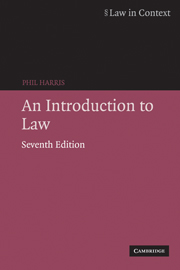Book contents
- Frontmatter
- Contents
- Preface
- Table of statutes
- Table of cases
- 1 Law and society
- 2 Law and morality
- 3 Law and the regulation of economic activity
- 4 Some important legal concepts
- 5 Law and property
- 6 Law and the settlement of disputes
- 7 The making of legal rules
- 8 The European dimension of English law
- 9 Liability in English law: the law of tort
- 10 Liability in English law: crime and the criminal justice system
- 11 The development and the role of the contract
- 12 Law and government
- 13 The legal profession
- 14 The judges
- Index
8 - The European dimension of English law
- Frontmatter
- Contents
- Preface
- Table of statutes
- Table of cases
- 1 Law and society
- 2 Law and morality
- 3 Law and the regulation of economic activity
- 4 Some important legal concepts
- 5 Law and property
- 6 Law and the settlement of disputes
- 7 The making of legal rules
- 8 The European dimension of English law
- 9 Liability in English law: the law of tort
- 10 Liability in English law: crime and the criminal justice system
- 11 The development and the role of the contract
- 12 Law and government
- 13 The legal profession
- 14 The judges
- Index
Summary
On 1 January 2002, 12 member states of the European Union – Germany, France, Spain, Ireland, Italy, Luxembourg, Belgium, the Netherlands, Austria, Portugal, Finland and Greece – adopted the euro as their official currency. This event was significant in a number of important respects, the main ones being first, that it marked an important stage in the move towards European economic and monetary union; second, that some member states of the European Union – Britain, Denmark and Sweden – chose not to join the common currency at that time (and this remains the case). Third, the fact that Europe is split on the euro issue is an indicator of the extent to which the European Union has embraced what has been termed a ‘twin-track’ situation in which some member states, through powers to opt out of European Union initiatives, choose to move towards European objectives at a different speed than others. This issue has become more acutely marked since the accession to the European Union of ten new member states in 2005 – Cyprus, the Czech Republic, Estonia, Hungary, Latvia, Lithuania, Malta, Poland, Slovakia, and Slovenia.
The history of the European Union has been one of gradual expansion of both its membership and its agenda. In terms of its member states, the original European Economic Community, created through the Treaty of Rome in 1957, consisted of six members – Germany, France, Italy, Belgium, the Netherlands and Luxembourg – who came together with the purpose of creating closer economic relationships.
- Type
- Chapter
- Information
- An Introduction to Law , pp. 215 - 240Publisher: Cambridge University PressPrint publication year: 2006



